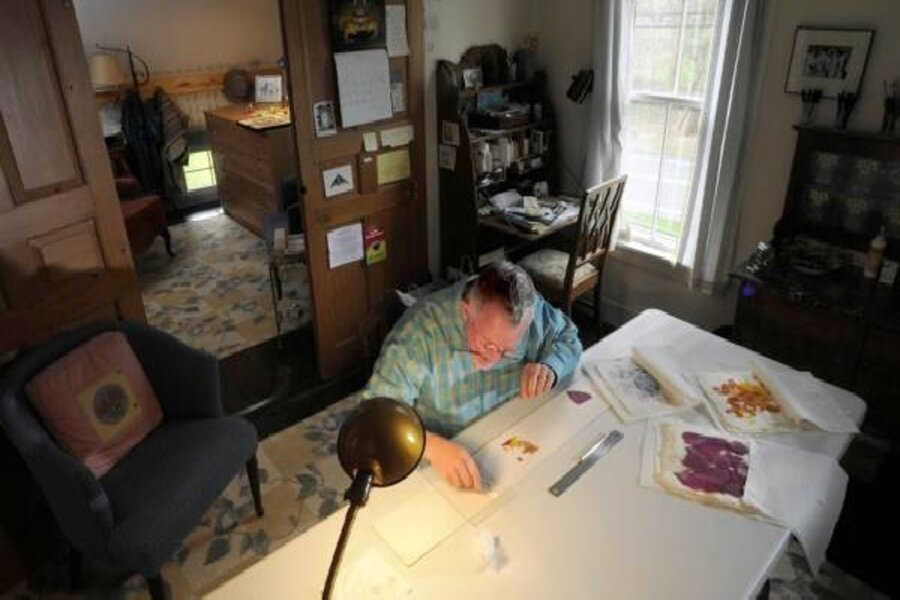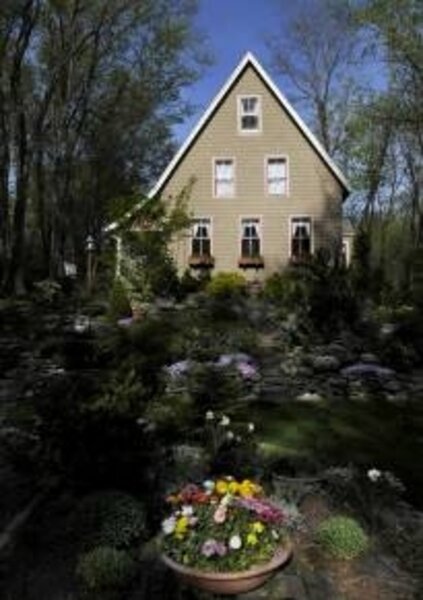A palette made of flowers
Loading...
| Glastonbury, Conn.
You can't help but notice all those flowers. Drive along Main Street in Glastonbury, Conn., and you'll spot a little tan cottage with a sloped roof and red trim.
It sits on the edge of wetlands, ringed with stone walls and walkways and terraces that burst with thousands of flowers, an almost madcap explosion of colors and shapes.
This is the home of Harry White, an exuberant artist who explains, "I've grown my own palette."
White uses real flowers in his art, an intricate form of collage he calls "fleurage." It's a far cry from dainty pressed flowers. His collages swirl with energetic colors and forceful imagery, such as the spectacular piece above his piano titled, "Full Moon: The Emperor's Robe."
What makes Mr. White's artwork so intriguing is that it isn't static. Like the sculptures of British artist Andy Goldsworthy, White's collages change over time.
"I'm going to shock you," he says, showing a photograph of "Full Moon" when he first completed it.
The colors have changed dramatically. A brilliant fiesta red has mellowed into a tawny beige.
"It's not that the original color is better," says White. "It's different. It's evolved. We're in a culture that simply can't handle that we age. I'm telling them: Age well."
White says he knows which colors will hold their own over time – such as the blues of his beloved delphiniums, the very permanent orange of a clementine peel and the "best" white, which is the skin around a bulb of garlic – and which colors are likely to fade. Sometimes he intentionally chooses petals because they will fade.
"After 35 years, I know what's going to happen," he says.
White, who grew up in Niantic and majored in interior design, specializing in fabric design, works as a personal florist and garden consultant. He also worked for a while creating window displays for a Boston jewelry store. That's evident in the design of the shelves in the kitchen of his cottage, which he has lighted and backed in fabric.
"The first thing you decorate with in a house is the light. Then the rugs. Then whatever you can fish out of the trash," he says.
White isn't kidding. A workbench that he found rotting in a field is now a handsome buffet in his dining room.
White's sense of humor also comes through in his collages. The background in one of his pieces is spinach: "Isn't that a riot?"
Another series of works is based on manhole covers he saw in a sidewalk. In another, he artfully weaves in an elastic remnant of an underwear waistband. And in an early piece, he used the tobacco from a cigarette butt he found in the gutter, a detail that he says entranced Eleanor Saidenberg, an early US. collector of Picasso's work, who encouraged him.
White says she told him he was "the American version of Kurt Schwitters," a German artist known for incorporating castoffs and found objects in his montages.
"The thing about Americans is you do things with such a sense of humor," White says she said.
Ms. Saidenberg also advised him never to let anyone tell him what to do in his artwork.
"That's one of the benefits of being an artist," he says. "You get to go into the zone. It's like a puzzle you put together."
He has used everything from wood shavings, paint peelings, bits of a wasp's nest, barbed wire and bark to sushi seaweed, seed heads and rose hips ("They look like they're dancing!"), along with the occasional bit of litter, like the foil of a Hershey's Kiss or a broken matchstick. Some of White's pieces are almost quiltlike; others look like stained glass.
He has experimented, such as a piece in which he stepped on the fragile flower petals with his sneakers to leave a subtle tread pattern. He sometimes takes a razor blade and stipples the petals when they are glued down on the board but still wet.
In his garden designs, too, White has seized upon the ephemeral. In one client's garden, he hung what he calls "a necklace of stones" attached to ivy, like a sculpture.
White's garden is featured in "The Inspired Garden: Twenty-Four Artists Share Their Vision" (Down East Books, 160 pages, $35), published in March.
Author Judy Paolini writes: "As a lifelong gardener, he knows that one thing he can depend on is change. No garden remains exactly the same from one year to the next, and every move made leads to another possibility. He revels in this constant motion."
The garden around White's cottage – which was built as an artist's studio in 1853 – "is the joy of my life," White says. "I am at one with flowers."
A slope down to the wetlands was all brush. He built a retaining wall and transformed it into his own personal Eden with daffodils, hollyhocks, tree peonies, irises, lobelia, marsh marigolds, mountain laurel, Jack-in-the-pulpit and primroses. And, of course, delphiniums: "I've slaved over them, but that's my blue.
White has built so many stone walls that his nephew told him, "Uncle Harry, you moved a mountain."
"I just did a little piece at a time," White says. "I'm out here playing all the time."
Editor's note: For more garden articles – at least one new one each weekday – click here. And don't forget to bookmark and drop by our lively garden blogs. Consider us a daily mini gardening magazine






